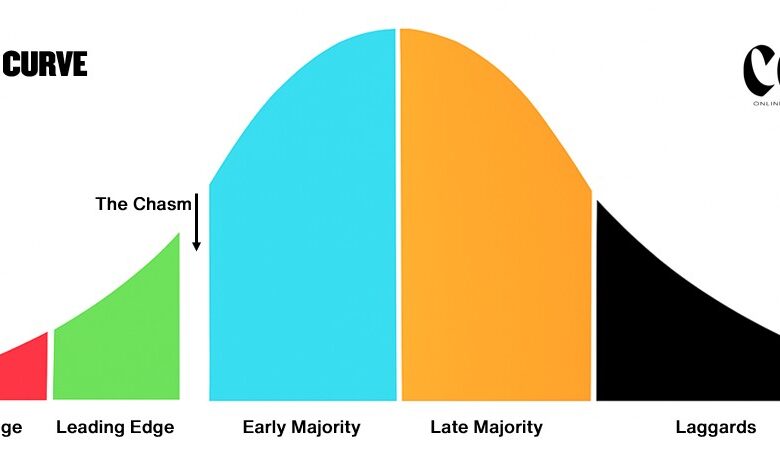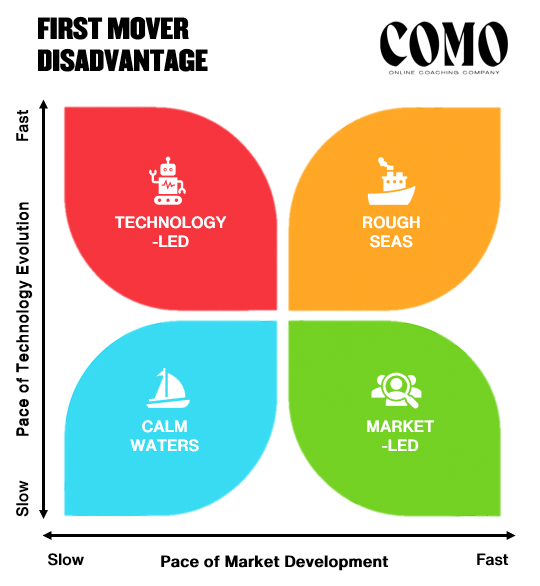
Entrepreneurs who love to “move fast and break things” are well aware of the First Mover Advantage – but in private enterprise, being first to market is not everything it’s cracked up to be.
Sometimes it pays more to be second, or to simply wait and follow the herd. As focus shifts from GenerativeAI to AgenticAI, what can we learn from extensive research into the use of technology in business, and how can you apply this to your business?
If you are using AI in your business, or think you should be, understanding two core models will help you continue to make the right AI decision for your business, at the right time.
Bleeding Edge v Leading Edge v Normal People
Some business owners love technology. Whether it’s key to your business or a personal passion, you enjoy spending time at the Leading Edge or even Bleeding Edge of new technology.
Not everything you test can work in your company, and not every new technology jumps ‘The Chasm’ into mainstream viability, but that’s just part of the fun.
For most SMB owners, however, technology is an enabler– it helps you run your business more efficiently, delivering a higher quality service with improved profit margins.
Bleeding and Leading Edge technologies are hard to implement in these businesses, because changes to technology (and solutions that ultimately don’t cross the chasm, so are discontinued) wreak havoc on a workforce where tech is meant to exist seamlessly in the background.
Where is AI on this Journey?
For those in the AI bubble, it can be hard to realise that the use of LLMs (like ChatGPT) is still in the Early Majority segment; and AgenticAI is a Bleeding Edge technology.
A recent survey of the Como Business Coaching client base showed that 100% of our clients have now used ChatGPT at least once, and almost 80% have a few team members who use “Chatty G” every week.
Yet that number drops below 50% when asked if they have used an alternative like Claude or Gemini (excluding when Gemini pops up unrequested on a Google search, or when you play games to trick it).
And the only Como clients who were able to describe the difference between “AI”, “GenerativeAI”, and “AgenticAI” are those with businesses actively selling technology solutions.
The speed of GenerativeAI adoption across SMEs has not been matched with AgenticAI and AI Agents, because neither has the underlying practicality in the technology.
And that’s OK.
When Wikipedia and iTunes Were New
You probably have employees and clients who were born in 2001, so you are forgiven for not remembering this specific article: First Mover Disadvantage by William Boulding and Markus Christen.
The key point the authors uncovered in their research for the Harvard Business Review is that sometimes it pays to be the first to market… and sometimes it doesn’t. Being first is not a guarantee of long-term victory.
This applies to your business whether you are developing an AI product, or just looking for how to use new tech to improve your operations.
The underlying framework Boulding and Christen uncovered looks like this:
Innovation (both product + market) can be mapped against two variables – Market Development and Technology Evolution.
- When both are Slow – neither the Market nor the Tech are changing much – you will experience Calm Waters.
- When both are changing Fast – you will experience Rough Seas.
In neither of these extremes is there much of a First Mover Advantage. A company attempting to position themselves differently will either battle the status quo, or face a market in turmoil where buyers don’t want to make any decision for fear of making the wrong one.
- The First Mover Advantage applies when Markets are evolving fast, even though Tech may not be innovating so much.
In this scenario, the changing Market is screaming for a new solution. Whoever provides that solution first will gain a huge advantage.
Apple under Steve Jobs’s second period as CEO did this incredibly well. Neither the iPod nor the iPhone featured leading edge technology, but they were packaged to perfectly deliver on what the market wanted (even if we didn’t know that’s what we wanted).
If you live in the Early or Late Majority, you probably thought the iPhone was cutting edge. When in reality, it was just set up and ready for the great wave of people to embrace smartphones.
- A First Mover Disadvantage applies when Technology is innovating fast, but the Market isn’t changing with it.
This was Steve Jobs’s first period as CEO of Apple – the one where the Board fired him. The Apple Macintosh was unquestionably a better piece of technology than its early-80s competitors … but that came with restrictions and at a price, neither of which the market was ready for.
When you launch a Tech-Led solution, it hurts. You will be forced to bleed money educating the market about what you are doing, how it can help them, why they should buy it – campaigns that can take years.
And then once your investment finally begins to pay off, and the market comes around? BOOM – you have a dozen competitors who didn’t have to invest in that education, and are ready to cut your grass.
The Second Mouse Gets the Cheese
You can read the original research for some (outdated) examples from the early days of the Internet and the Dot Com bubble.
Unquestionably, this dynamic is playing out within the current AI space. ChatGPT was not Beta software, and like the competition it benefited from more than 50 years of academic research.
In 2025, the technology underpinning AgenticAI and AI Agents is moving fast. Importantly, in private enterprise anyway, our research and anecdotal observations on the ground show that the Market is evolving but not as Fast as it may seem.
Changing any piece of tech in your business is a risk. Introducing a whole new category of tech into your business needs to have an obvious return on investment – either because you’re good at this stuff (so can make it work, or don’t mind learning if it doesn’t work), or because you’ve had time to watch others on the adoption curve test, refine, and perfect.
Those companies creating AI Agents for businesses need to understand that they are currently selling to Bleeding Edge and Leading Edge organisations. AI Agents will unquestionably leap the chasm and become mainstream – that doesn’t necessarily mean the existing companies will successfully make the leap.
What this means for regular business owners is that placing a bet on any current solutions is risky – they may not be around in 2 years’ time. This uncertainty is what creates that chasm in the first place, and it means most new AI solutions are Tech-Led and have no First Mover Advantage.
So No Pressure, Yet
This is great news if you are worried your SMB is about to miss the AI boat. You aren’t.
You have some decisions to make:
1. Where do you place yourself and your company on the Adoption Curve? Do you love the latest and the latest, at the Bleeding Edge? Are you further along, maybe even in the Late Majority?
Consciously choosing any of those segments is perfectly valid. Just don’t bury your head in the sand, or be pressured to leap uncomfortably forward.
2. When you evaluate a new tech solution for your business (including anything AI), ask yourself who the current market is for that tech-led solution? Has it been proven sufficient for the Early Majority, or is it still Leading Edge? Given the disruption that the wrong tech can have on an SMB, choosing tech that doesn’t match your company’s place is fraught with danger.
3. Where are your “competitors”? Under about 1000 employees, there’s no such thing as competition – still, it can be useful to look around at other companies who are selling a similar product to your market.
Are they pitching a Tech-led solution, and having to invest in all that market education? If so, watch and prepare for when the market is ready (or the competitor proves there is no market, yet).
Or have they found the Market-led opportunity, taking a proven technology and packaging it in a way that the Majority are clamouring to get onboard. That’s the innovation you want to replicate as a priority.
Introducing Jacob Aldridge
Jacob Aldridge is an international business advisor and portfolio entrepreneur, having worked over 20 years with more than 400 private companies in 14 countries.
A deep generalist with a keen eye for the off-kilter and slightly absurd, Jacob has the uncanny knack of distilling complex concepts into simple soundbites and powerful strategies that founders, executives, and team members both love … and execute
Twice named in the Coach Foundation’s ‘Top 20 Business Coaches in the World’, Jacob was also nominated for the Virtual Speakers Hall of Fame in 2023 and uses his life as a perpetual traveller and digital nomad to learn from and educate private enterprise around the world.






